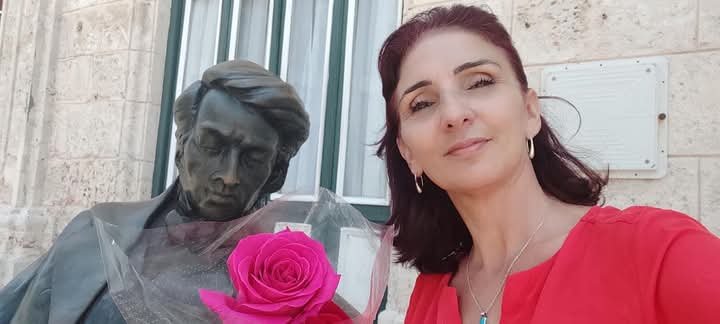Hello, friends of Humanitas.
I want to begin by explaining my point of view on beauty. Beauty is one of those matters that, the more subjective, the more controversial it becomes.
Beauty is like art. In fact, it is said that art is beauty, poetry is beauty. And they are right. But when we talk about beauty, we are talking about a pattern or an aesthetic taste for something that varies as much as the point of view from which it is observed.

Two people can be looking at the same painting, and one may say it is beautiful, while the other thinks it is horrible. The same can happen when talking about a woman, a man, a literary work, or a musical work. To give just a few examples.

Everything depends on the perspective from which the object of beauty in question is observed. And that perspective can be conditioned by various historical variables, by the geographical area where we live, or by the sociocultural conditions of the time.
For now, let's talk about beauty in men and women.
We see examples of this even as far back as the Egyptians. At that time, eye makeup (kohl) was more than just for aesthetic purposes; it was also used to protect against the sun.
What was considered beautiful in the Renaissance was completely different from the Middle Ages. In the Renaissance, a beautiful woman was considered to have rounded hips and breasts; While in the Middle Ages, thin women with small breasts were considered more beautiful.
Without reaching generalities, of course, something similar happens today when observing European aesthetic tastes compared to Latin American ones.
In European fashion shows, thin women with few curves are considered beautiful, while Latin Americans prefer the Renaissance beauty canon.
We can also see how Asians generally prefer Asian features. However, in recent years, some Asians have undergone cosmetic surgery to modify their features and Westernize them. As if adopting these features would make them more beautiful.
And of course, canons like these existed, exist, and will continue to exist. However, they have never been general.
Throughout the ages, women have liked men who are short, tall, strong, thin, athletic, overweight, bald, with long hair, with chest hair, or those without any.
While men have been attracted to curvy or non-curvy women, whether white or other skin tones, Asian, Latina, African, or Nordic.
There are even beauty standards where greater beauty or aesthetic values are found in the mix.

My point is just as the saying goes: colors are for all tastes, and flowers are for all sorts.
Beauty, or the concept of beauty, would be something similar to the concept of love: each person has their own, and none are wrong.
This applies as much to human beings as it does to art or anything else.
And so far I've talked about physical and aesthetic beauty. I could also talk for hours about spiritual beauty, the kind that resides within each of us.
For me, spiritual beauty is what matters. This is found in works of art as well as in people. There are paintings, musical works, sculptures, and novels, charged with spirituality and ethical and moral values that add greater beauty to the work.
For me, this is what makes humans beautiful. It's useless to be beautiful on the outside and completely horrible as people on the inside.
And finally, I'd like to talk about the beauty in what we do. My husband, for example, says he noticed me the first time he saw me playing. He says it was the most beautiful thing he had ever seen up to that moment.
He says that moment inspired him to write the first poem he ever wrote about me.

And that's one of the most beautiful things anyone has ever said or done to me.
Versíon en español
Hola, amigos de Humanitas.
Quiero comenzar explicando mi punto de vista sobre la belleza. La belleza es de esos asuntos que, entre más subjetivos, más polémicos se vuelven.
La belleza es como el arte. De hecho se dice que el arte es belleza, la poesía es belleza. Y tienen razón. Pero cuando hablamos de belleza hablamos de un patrón o un gusto estético sobre algo que varía tanto como el punto de vista desde el que se observa.

Dos personas pueden estar observando el mismo cuadro y uno decir que es hermoso mientras que al otro me parece un horror. Lo mismo puede suceder cuando se habla de una mujer, un hombre, una obra literaria o una obra musical. Por solo poner algunos ejemplos.

Todo depende desde el punto de vista desde el que se observe el objeto de belleza en cuestión. Y ese punto de vista puede estar condicionado por disímiles variables históricas, por la zona geográfica dónde vivimos o por las condiciones socioculturales de la época.
De momento, hablemos de la belleza en hombres y mujeres.
Ejemplos de esos los vemos incluso desde la época de los egipcios. En aquel entonces el maquillaje utilizado en los ojos (el khol) era más que un simple uso estético también lo era para protegerse del sol.
Lo considerado bello en la época renacentista era completamente diferente a la edad media. En el Renacimiento, la mujer bella era aquella que poseía formas redondeadas en caderas y senos; mientras que en la edad media, la mujer delgada y de pechos pequeños era considerada más hermosa.
Sin llegar a generalidades por supuesto, algo similar sucede en la actualidad cuando se observa el gusto estético europeo en comparación con el latino.
En los desfiles de moda en Europa la mujer delgada y con pocas curvas es considerada hermosa mientras que a los latinos les gusta más el canon de belleza renacentista.
También podemos ver como por lo general, a los asiáticos les gustan los rasgos asiáticos. Sin embargo en los últimos años algunas personas en Asia se han realizado cirugías estéticas para modificar sus rasgos y occidentalizarlos. Como si al adoptar estos rasgo se volvieran más hermosos.
Y por supuesto que cánones como esos existieron, existen y existirán. Sin embargo, nunca han sido algo general.
En todas las épocas, a las mujeres les han gustado los hombres bajos, altos, fuertes, delgados, atléticos, subidos de peso, calvos, con pelo largo, con vello en el pecho o los que no tienen ninguno.
Mientras que a los hombres han sido atraídos hacia mujeres con curvas o sin curvas blancas o de otro color asiáticas latinas africanas nórdicas.
Incluso hay cánones de belleza donde en la mezcla se encuentra mayor hermosura o valores estéticos.

Mi punto es tal y como dice el dicho: para gustos, los colores y para escoger, las flores.
La belleza o el concepto de belleza vendría siendo algo parecido al concepto de amor: cada uno tiene el suyo propio y ninguno está errado.
Esta se aplica tanto a los seres humanos como el arte o cualquier otra cosa.
Y hasta ahora he hablado de la belleza en lo físico y estético. Podría también estar hablando horas de la belleza espiritual. De esa que reside dentro de cada uno de nosotros.
Para mí la belleza espiritual en la que vale. Este recibe tanto en las obras de artes como las personas. Hay cuadros, obras musicales, esculturas, novelas, cargadas de esas espiritualidad y valores éticos y morales que le agregan mayor belleza a la obra.
Esto para mí en los humanos es lo que los hace hermosos. De nada vale ser bellos en el exterior y completamente horribles como personas en nuestro interior.
Y por último quisiera hablar de la belleza en lo que hacemos. Dice mi esposo por ejemplo que se fijó en mí la primera vez que me vio tocando. Dice que fue lo más hermoso que había visto hasta ese momento.
Cuenta que ese instante lo inspiró a escribir el primer poema que me hizo.

Y eso es de las cosas más hermosas que me hayan dicho y hecho alguna vez.



